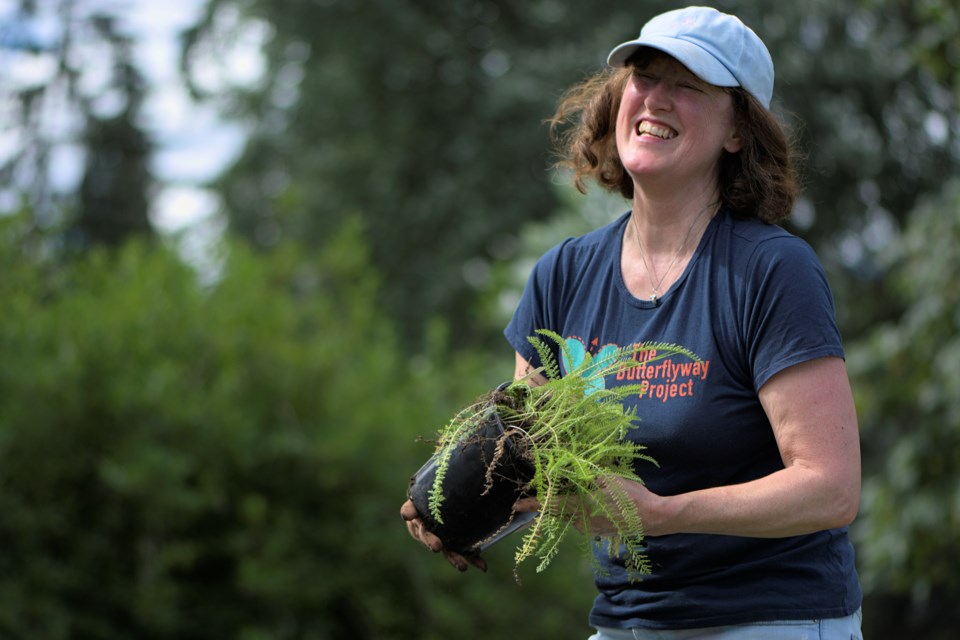A new public garden has local residents buzzing, literally.
Bees, butterflies and birds were in attendance last Thursday (July 7) as volunteers and city workers finished planting a garden for pollinators on Grand Boulevard in North Vancouver.
The project coming to fruition is the first-of-its kind in the city, and follows months of co-ordination with the municipality.
The pollinator garden is the result of a partnership between the City of North Vancouver, the David Suzuki Butterflyway Project, and members of the Lynn Valley Garden Club to create habitat for animals vital to food production. In recent years, alarming declines have been observed in important pollinator species.
The City of North Vancouver is encouraging citizens to create their own pollinator-friendly habitats at home, and the public garden – on the west side of the park between East 17th and 18th streets – is in part designed to educate passersby.
CNV environmental technician Frances Ramsay says the city will be adding informational signage by the garden with a link to their website, which will be added to as the project develops.
“The Grand Boulevard community pollinator garden is a trial project with the hope of extending the garden in future to create corridors for bees, butterflies and birds,” she said. “Building this network will require both public and private landowners to create pollinator friendly gardens.”
The closest other existing pollinator garden is in Gerry’s Garden at Loutet Park. Ramsay said it would be great to build a connection between these two habitats, and residents can help by making pollinator-friendly spaces at home.“With community support we also hope to expand the Grand Boulevard pollinator garden in future,” she said.
It's not just about butterflies. 'It's about citizen science'
Sally Hocking and husband Stephen Deedes-Vincke, volunteers who helped lead the public planting, became Butterflyway Project rangers in 2018.In the laneway behind their home, they created the District of North Van’s first “butterflyway” between 300 block Bournemouth Crescent and 2800 block Dollarton Highway. Now, after collaborating with several of their neighbours, it’s been dubbed a Butterflyway Lane that’s identifiable on Google Maps.After becoming rangers, the David Suzuki Foundation provided training, a starter kit of plants and an identification book. They also connected with other rangers online through a North Shore ranger Facebook page.
Hocking explained that supporting pollinators is a cause people are really getting behind now.
But the project isn’t just about butterflies. “It's about citizen science and bees, and insects as a whole,” she said.
“One-in-every-three mouthfuls that we eat is actually created by pollinators, so without pollinators, we're not going to eat the same as we do now,” she continued.
To make the Grand Boulevard garden and others like it successful, careful planning is required to know what to plant and how.
Boulders were dug up at the site to provide warm surfaces that butterflies bask on. Native mahonia were planted near the North end of the garden for shelter from chilly Northern winds in the winter.Oso berries were included because they’re one of the earliest to flower in the spring and queen bees come to feed on their nectar. “And that nectar for the queen is fundamental to the survival and creation of the whole bee nest through the summer,” Hocking said, “because unless the queen has that early nectar, then they can't lay eggs and create a colony.”Mock oranges, which can reach eight-to-10-feet tall, were planted to attract things like swallowtail butterflies, which fly higher above the ground.
To reach its full potential, the garden also has to be pleasing to the eye.
“We've got a wonderful mix of garden plants that are really good and long-lasting for nectar and bloom through the summer because this is also a public space. A lot of people want it to look great as well as do the job of encouraging talking.”




